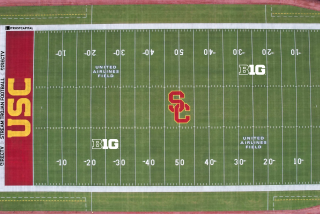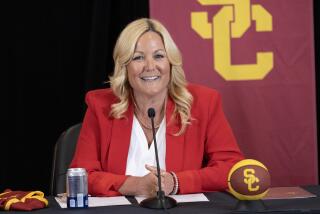COMMENTARY : NCAA’s Greed Is Showing
Well, the college folks are really doing it up right this time. In its January convention, the National Collegiate Athletic Assn. is probably going to enact a bunch of rules saying, in effect, that unless you can spend with the big boys, you can’t play with the big boys--even if you can beat them.
This should be remembered as the convention when the NCAA voted to take away David’s slingshot.
Ah, romance. And the old college try.
Try this instead: The college powers have put together a package that asks, and not so nicely, that everyone else go home. Here are some of the highlights: In order to play any sport on the Division I level, a school must play all its sports on the Division I--or highest--level. The proposed rules mandate that a college must extend 50 full scholarships in sports other than football and basketball to be eligible to play any Division I sports (or spend $500,000 on these scholarships). Also, the college must field a minimum of 14 Division I teams, or none at all.
Confused? I don’t blame you. In simpler terms, it means that Johns Hopkins, unless given special dispensation, can’t play Division I lacrosse and non-scholarship Division III everything else. It means that if Towson State wants to cut back its losing football program from Division I-AA to Division II or Division III, Towson can’t play Division I basketball or gymnastics or lacrosse. Because of these new rules, Towson may have to drop football altogether.
How does the NCAA justify these actions? Do the big schools pushing these proposals simply admit their greed and be done with it? Not exactly.
Instead, they say that Division I has gotten unwieldly, with as many as 300 schools competing in basketball, where the stakes -- thanks, in part, to CBS-TV’s billion-dollar contract -- have become enormous. They say that similar schools with similar commitment down the line to college sports should be grouped similarly. In other words, Towson State should butt out.
Is this greed at work?
“You’ve got that right,” Maryland Athletic Director Andy Geiger said. “Any school that wants to express itself ought to have that opportunity. Who is the University of Maryland to decide Towson State can’t have a first-rate gymnastics program if they want to limp along in football?
“Let everyone play who wants to. Who’s it hurting? We ought to give David a chance to play Goliath. That’s what’s fun.”
Well, excuse Geiger. He’s the guy who voted against Atlantic Coast Conference expansion because he thinks there is more to college sports than grabbing all the available money. That is, of course, a distinctly minority opinion. Just look around. The big conferences are gobbling up all the major independents. Not so long after the major football powers broke away from the NCAA so they could negotiate their own TV contract, Notre Dame broke away from the other powers to negotiate a package of its own.
In college sports, there is much talk -- only that, of course -- about beginning the hard job of cleaning up its house, hard by the Love Canal. When CBS said it would fork over the billion dollars for the NCAA basketball tournament, a committee set to work to study how this windfall might best be spent. Among the ideas discussed was one tying disbursement to graduation rates. Guess what they did instead? They decided that the schools with the most programs and the most scholarship athletes get the largest hunk of the pie.
It’s the growing pie that is behind all this. Many schools have tried to produce Division I basketball programs so that they might get a slice. The big-time basketball schools, which could, after all, produce their own TV contracts, want all the pie for themselves.
Oh, there is some additional funding put aside for the Division II basketball tournament as an incentive for smaller programs to return to competition at a more comfortable level. But that means -- and here’s the strange part -- that those schools couldn’t compete in any sport on the Division I level.
Why not?
That’s the question many schools are facing. Georgetown and St. John’s, two basketball powers, will probably have to drop their Division III football programs, meaning students there can’t play football. Why does Towson have to raise its student fees from $270 to $370 or drop football?
“They’re trying to separate the men from the boys,” Towson Athletic Director Bill Hunter said. “They figure that if you don’t pay your dues, you shouldn’t get a shot at the pot of gold. I don’t know what’s right or wrong. But I know it puts an onus on us and a lot of other schools to make fundamental changes because we can’t afford 95 (football) scholarships or have 100,000-seat stadiums.”
Towson made it to the NCAA basketball tournament last season. It went to the nationals in women’s gymnastics. It’s not a big-time sports power, but it has some big-time programs. Now, that’s not good enough. Here’s the message to Towson (and you wonder how anyone could vote for it in these overheated days of college scandal when academics are routinely ignored and athletes exploited): Get bigger or get out.
More to Read
Go beyond the scoreboard
Get the latest on L.A.'s teams in the daily Sports Report newsletter.
You may occasionally receive promotional content from the Los Angeles Times.










